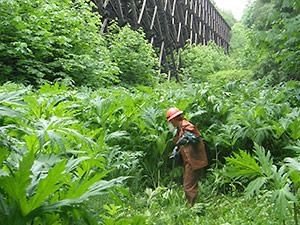Public reporting has been pivotal in limiting the spread of noxious weeds, says a member of the Coastal Invasive Species Committee (CISC).
Dave Murphy is director on both Powell River Regional District board for Texada Island and CISC, one of 17 non-profit societies in BC which aims to raise awareness and share information about invasive plants and animal species that threaten local ecosystems.
“The public has been a big help in helping to point these plants out,” said Murphy.
For the past six years the provincial government has operated a report-a-weed hotline and since 2011 CISC has had its own regional hotline.
The ministry of forests, lands and natural resource operations recently released smartphone apps for reporting weeds.
While there have not been many reports of giant hogweed on the Sunshine Coast, Murphy said that the hotline has “worked very efficiently on Vancouver Island.” The committee faced a large growth of the toxic plant in French Creek and in the Comox Valley.
“It’s number one on the hit parade for invasive species,” said Murphy. “It’s a nasty plant.”
Giant hogweed’s sap reacts to light and can cause severe burns and blisters if it comes into contact with skin. The plant’s pollen will cause a sore throat in anyone who happens to breathe it in.
Murphy said that sites near Lund and south of town have been treated.
Ernie Sellentin has worked for the past four years as a CISC project operations coordinator to limit the spread of invasive plants in the region. Previous to that he was employed by the provincial government in its invasive plant program as a field technician for the Coast Forest region. He is based out of Comox and works with members of the committee to identify areas in need of management and organizes field crews.
Sellentin said he and his crews are fortunate that they rarely ever have to deal with the plant in full bloom. It can grow over three metres in height with leaves a metre and a half in width. It can have rounded clusters of white flowers almost a metre across.
“It’s a very impressive plant,” he added, “but we get a lot of reports that turn out to be false.”
Sellentin said that cow parsnip is often confused with giant hogweed because of its similar looks. Its sap also has some of the same burning properties but at only a fraction of the strength.
This summer the committee received reports of a growth of giant hogweed at Myrtle Point Golf Course. After inspection though, the plant turned out to be cow parsnip.
Sellentin said that since the regional committee was established 10 years ago, the response to invasive species has improved because one key in fighting the plants is to identify them before they spread widely.
“If a new species shows up we’re ready, but Scotch broom and knapweed we can’t do much about now,” he said. “Had we been on it 15 years ago we could have gotten rid of it.”
Crews employ different means of removing the noxious weeds, but more often now herbicides are used in the fight.
Murphy said the committee has recently had its scope broadened to include insects and shellfish in addition to plant species.
He said that he was concerned about recent reports of tiny Argentine and European fire ants on Vancouver Island. For more information about how to report weeds, readers can visit CISC’s www.coastalisc.com.



